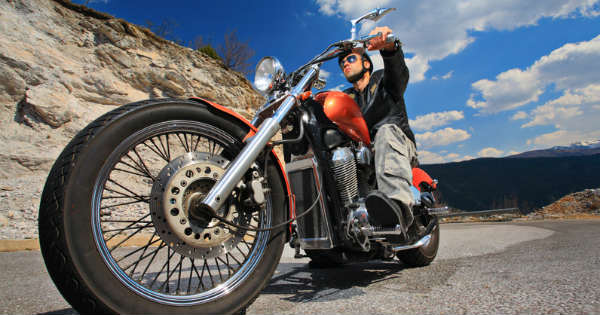If you’re a motorcycle rider, you know nothing compares to that exhilarating feeling of freedom while you travel down a highway or country road without a seat belt or being surrounded by doors or windows. Unfortunately, it’s that lack of extra protection that makes motorcyclists 27 times more likely to die in a crash compared to passenger car operators. Even if you think you know everything about motorcycle safety, it’s always a good idea to get a refresher, especially now that warm riding weather is here. Here’s how to ride a motorcycle safely and prevent injuries to yourself and others.

Wear a Helmet
Even if your state doesn’t require that motorcyclists wear helmets, there’s no denying the fact that using headgear saves lives. Wearing a helmet while riding a motorcycle cuts the risk of death by 37%.
But besides protecting your noggin while you’re out there two-wheeling, helmets with face shields will prevent dust, insects, and road debris from making contact with your eyes, nose, or mouth. It also shields you from wind, rain, and other weather conditions that can hinder your visibility.
If your helmet doesn’t have a face shield, invest in a pair of goggles to protect your eyes.
Wear Protective Clothing
In addition to protecting your head and face, you’ll want to wear the right clothing to protect your body in case of an accident. You definitely don’t want to experience scraping exposed skin against asphalt, concrete, or gravel. Appropriate motorcycle riding gear includes leather or denim pants and a jacket or vest, boots that cover at least your ankles, and gloves designed to help you grip the handlebars better.
Wearing an article of brightly colored or reflective clothing can also help make you more visible to other drivers.
Respect Traffic Laws and Other Drivers
It’s tempting for motorcyclists to do things they’re unable to do in a vehicle, such as weaving in and out of tight traffic and popping wheelies. However, you need to follow road laws and respect other drivers so that you and others can stay safe.
Become familiar with what is and isn’t allowed when it comes to pushing the road rules on two wheels. For example, in California motorcyclists are allowed to split lanes, but the practice is currently illegal in the rest of the U.S.
Avoid tailgating other drivers and use your turn signal. Motorcycle operators should abide by the same road rules as passenger car drivers.
Stay Visible
Riding a narrow vehicle such as a motorcycle makes it easier for you to slip into other drivers’ blind spots. Trucks and semitrailers in particular have larger blind areas, so use caution when riding near or passing one.
Be wary of cars when they make left-hand turns, as this is when a motorcycle is not visible to the car’s driver. It’s a good idea to assume that no one can see you when you ride a motorcycle.
Be sure to drive defensively and be aware of your surroundings at all times. Accidents are more likely to happen when a rider lets their guard down.
Choose a Bike That’s the Right Match
A newbie motorcycle operator buying a bike with more power than they can handle is like an inexperienced equestrian trying to control a thoroughbred. Make sure you choose a bike that you feel confident riding and that it doesn’t have more speed than you need. Get familiar with all of the controls and how to safely operate your ride so you don’t put yourself and others at risk.
It’s also a good idea to receive continuing education and take motorcycle riding courses to become a better driver even after you earn your operator’s license. Test driving different bikes will introduce you to new models and help you get used to the way unfamiliar bikes handle.
Be Mindful of Weather and Road Conditions
On that note, some motorcyclists feel completely comfortable riding in the rain or on slippery roads. However, bikes, in general, aren’t as equipped as passenger cars and SUVs when it comes to handling poor weather.
You can cut your risk of getting into an accident by only riding your motorcycle if the weather and road conditions are good. Check the weather report before venturing out on a road trip or long drive.
Although it is possible to ride your bike in the snow, not all models are designed for winter driving. The exposure to the cold temperature also doesn’t make for a pleasurable ride, unless you’re wearing the right protective clothing.
Maintain Your Bike
Just as cars need routine scheduled maintenance to help them run their best, motorcycles need to be serviced as well. Read your owner’s manual to find out when you should bring your bike in for oil changes and other regular services.
Become familiar with checking over your motorcycle and making sure everything is in good operating condition before hopping on. Check for oil leaks, make sure all fluids are filled to the right levels, and confirm your headlight and turn signals light up.
Stay Alert and Sober
Needless to say, you don’t want to operate your bike if you’re under the influence of alcohol, drugs, or medications that can make you drowsy. Never drink and ride. Resist riding when you’re sleepy — if possible, take a nap first to refresh yourself first before getting on the road.
Know How to Ride a Motorcycle Safely
Knowing how to ride a motorcycle safely will make you a more confident driver who knows to avoid accidents and injuries. Always put safety first.
For more motorcycle safety tips and advice on how to keep your ride in tiptop shape, check out our Bikes archive.




